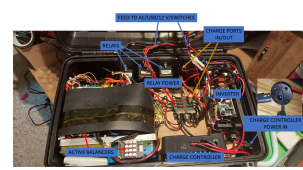I have thought about a solar system for years but only started getting serious recently. After a recent ice storm left us without power for 44 hrs I knew it was time to do something. I started watching tons of videos and researching products. Initially I wanted cheap and easy 12v but soon after the videos I was sure the 24v was best for me, I thought 48v would be overkill unless I went to the full/partial home system. Then in another thread I received a link from Danke on a video for a 3000W solar power cart. Out of curiosity I started researching 48v and now I am leaning that way.
With the changes due to researhing options I think I am doing fine and haven't spent money on things only to decide on something else.
So now looking for advice and opinions on a 48v system. Here is what I am thinking of right now. And to maintain one key brand instead of mixing brands.
EG4-LL Lithium Battery (V2) | 48V 100AH | Server Rack Battery $1700
EG4 3kW Off-Grid Inverter | 3000EHV-48 | 3000W Output | 5000W PV Input | 500 VOC Input $675
(Pre-Assembled) EG4 Enclosed Battery Rack | 3 Slot | Wheels Included $550
12V 200 Watt Bifacial Solar Panel 10BB Mono High Efficiency Solar Panels 4 at $185 each
My thoughts on portable is temp home use, taking out in the yard instead of stretching out multiple extension cords and taking camping. Plus learning before the bigger home investment.
The rack runs it up a bit but allows for future expansion and would be beneficial for converting to a off-grid home system. There would be other upgrades needed then.
With the changes due to researhing options I think I am doing fine and haven't spent money on things only to decide on something else.
So now looking for advice and opinions on a 48v system. Here is what I am thinking of right now. And to maintain one key brand instead of mixing brands.
EG4-LL Lithium Battery (V2) | 48V 100AH | Server Rack Battery $1700
EG4 3kW Off-Grid Inverter | 3000EHV-48 | 3000W Output | 5000W PV Input | 500 VOC Input $675
(Pre-Assembled) EG4 Enclosed Battery Rack | 3 Slot | Wheels Included $550
12V 200 Watt Bifacial Solar Panel 10BB Mono High Efficiency Solar Panels 4 at $185 each
My thoughts on portable is temp home use, taking out in the yard instead of stretching out multiple extension cords and taking camping. Plus learning before the bigger home investment.
The rack runs it up a bit but allows for future expansion and would be beneficial for converting to a off-grid home system. There would be other upgrades needed then.





